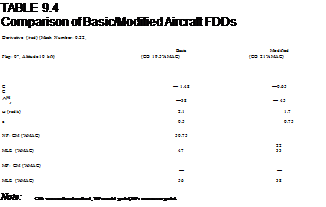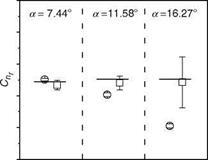Fighter Aircraft FA2
An unstable aircraft cannot fly without the aid of a flight controller, thereby rendering the entire system as a closed loop control system. However, the estimation of derivatives of basic unstable aircraft (open loop system) is of primary interest for many applications in the field of flight mechanics, especially for the validation of the math models used for control-law design. The accuracy of the estimated derivatives in such cases is adversely affected by the feedback from the flight controller, which tends to produce highly damped responses and correlated I/O variables. Using the filter error program it was shown that better estimation can be achieved if modeling errors arising from data correlation are treated as process noise. Parameter estimation of an augmented aircraft equipped with a controller was carried out using output error and FEMs. It was shown that the feedback signals from the controller and the aileron-rudder interconnect operation cause correlations between the I/O variables, which degrade the accuracy of the parameter estimates. FEM was found to yield reliable parameter estimates, while the aircraft derivatives estimated from OEM did not compare well with the reference derivative values. Parameter-estimation results from data generated from a research simulator for an unstable augmented aircraft are plotted in Figure 9.4. Due to the model compensation ability of FEM, the derivatives estimated show better match with wind-tunnel values compared to the derivatives estimated from OEM [17].
9.4.2 Basic and Modified Transport Aircraft
A program to modify a transport aircraft to carry some electronics payloads was taken up. It was important to establish the incremental effects on the dynamic
|
—– Wind tunnel values О Estimated from OEM □ Estimated from FEM |
FIGURE 9.4 Parameter estimation using FEM and OEM for an unstable/augmented aircraft FA2.
derivatives due to the modification in the aircraft. The aircraft has a medium range with two Rolls Royce Dart turboprop engines. It has manually operated controls for elevators, rudder, and starboard ailerons. On the modified aircraft an external structure was mounted on the pair of pylons fixed to the fuselage of the basic aircraft. The modified aircraft was expected to have some altered characteristics compared to the basic aircraft. Hence, it was very important to predict its characteristics and handling qualities. Several planned maneuvers were performed on this transport aircraft: DR, steady turn, sideslip wings level, sideslip steady heading, roll performance, longitudinal stability, SP/phugoid, stall, and RC. The dynamic data were acquired at the rate of 32 samples/s and corrected using kinematic consistency checking and subsequently used for parameter estimation. The math models used are given in Ref. [18]. Some results are shown in Table 9.4. The other results were found to be consistent across various flight conditions (Mach number and altitude).
Some LD characteristics of the modified aircraft are given in Table 9.5. The damping-in-roll and the static stability of the modified aircraft were quite improved compared to the basic aircraft. However, the DR frequency and damping were poor for the former when compared to the latter. The LD static stability was improved; this could be due to the pylons providing additional vertical surface above the fuselage (similar to the vertical tail). The predicted longitudinal and LD HQs were validated by the flight (test data) derived HQs for both the aircraft [18].
A new procedure for estimation of neutral point (Appendix A) is applied to the basic and the modified configurations [19]. The experiments were conducted at three CG points. In the classical method of neutral point estimation, the lift coefficient was determined from the airspeed and the weight data. The results (on the average) of neutral and maneuver points (as percentage of MAC) estimated by using parameter – estimation method are also shown in Table 9.4. The new method is expected to be highly reliable because the data used are corrected by kinematic consistency, and the longitudinal static and maneuver stability of the aircraft are extracted from the
 |
SP dynamic response parameters Ma and the natural frequency ы^, which vary consistently with the location of CG. We see that the static stability of the modified aircraft is reduced compared to the basic aircraft; however, the damping is increased as seen in Table 9.4.












